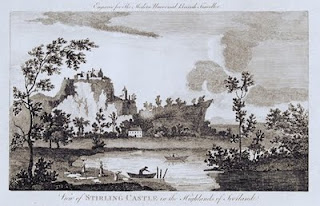Eyre Massey my Irish 6x great uncle fought on the wrong side, from my Scottish point of view, at the Battle of Culloden, the last battle fought on British soil. Massey’s military career was built on the bravery he showed that day. There, the Scottish Highlanders were massacred by a Hanoverian army of English, Irish and lowland Scots, and the Jacobite cause of an independent Scotland was ended.
Instead therefore, I prefer to concentrate on the second-last battle, fought three months earlier and 100 miles further south! If the Scots had been able to capitalise on their successes that day, the English advance might well have stalled along with Massey’s career.
The Jacobites had retreated from their advance deep into English territory, but were at full strength and in high morale, 8000 of them encamped at Bannockburn to the south of Stirling. Massey was with Blakeney’s Regiment, under siege in Stirling Castle where they had been garrisoned to harry the rebellious Scots from within Scotland’s borders.
For the Hanoverian English, an army of 13000 arrived in Edinburgh, and an advance party of 6000 was sent on to relieve the siege at Stirling. But Blakeney, a soldier’s soldier very much in the same mould as Massey, had simply been biding his time, allowing the Scots to commit time, men and money to the siege; hearing of the English advance he easily broke out of Stirling Castle, catching the besiegers by surprise and killing some 300 of them on his way to joining the relief column at Falkirk, a small town southeast of Bannockburn.
Thus it was that Massey found himself on the left flank of the Hanoverian army as the two sides lined up against each other on 17th January 1746. Despite the strength of the Hanoverian forces they were caught unaware, largely because their commander General Henry Hawley refused to believe early reports of the Jacobite advance on his position. Rushing to meet them at last, Hawley’s men were faced with an uphill climb across boggy ground towards the Highland Scots occupying the ridge of Falkirk Hill.
Battle lines on Falkirk Muir, 4pm, 17th January 1746
(plan from Wikipedia)
By four o’clock in the afternoon, with the two sides facing each other and spoiling for a fight, the short Scottish winter day was already drawing to a close. As dusk fell, the wind picked up and brought heavy icy rain. It was uncomfortable weather and a bad time of day for a battle.
The right flank was protected by a deep ravine from attacking or being attacked. So it fell to English cavalry on the left to lead the charge, past Blakeney’s infantry, where they faced three regiments of the Macdonald clan. The cavalry were routed by volleys of Scottish pistol fire and by a tactic of wounding the horse not the rider. As the survivors fled, the highlanders drew their claymore swords and charged. It must have been terrifying. The English front line turned and ran – Eyre Massey and the rest of his regiment, in the second line, were simply swept away in the retreat. It fell to Massey and his fellow grenadiers to pull some of the English cannon from the bog, because the horses had all been lost.
wind and rain also shown
The fighting lasted less than half an hour. In the chaos of the rout the Hanoverian army fell back eastwards, first to Linlithgow and then to Edinburgh. As night came on, the wind became a winter storm of piercing cold sleat. Many English lives were probably spared by the poor visibility and confusion. Only in the grey light of morning were the Jacobites able to see the extent of their victory on a battlefield covered by hundreds on Hanoverian dead.
If the Scots had built on the momentum of this convincing and morale-boosting engagement, the future of their Jacobite cause might have been very different. But instead of pursuing the defeated and disorganised English army, they waited for weeks at Bannockburn for their heavy-drinking leader Charles Stuart, Bonnie Prince Charlie, to recover from a head cold and make some decisions. The English were given time to regroup under a new commander, the Butcher Duke of Cumberland. Charles gradually retreated northwards, fighting a defensive rearguard action instead of seizing the offensive.
to celebrate the victory of the Duke of Cumberland (1721-1765)
(from the US Library of Congress)
By contrast Cumberland moved swiftly north along the east coast of Scotland, supplying his troops by ship. After six weeks spent in training at Aberdeen his forces were well-fed and highly disciplined. The defeat which he was able to inflict on the Jacobite army at Culloden on 16th April 1746 was crushing and final. Thanks to his subsequent patronage of Eyre Massey (then a lowly lieutenant whose bravery at Culloden had caught the Duke’s eye) my ancestor rose through the ranks to become a general, and was eventually elevated to the Irish peerage as Lord Clarina. And I suppose you don’t get all that just for pulling some guns out of the mud in defeat.









No comments:
Post a Comment